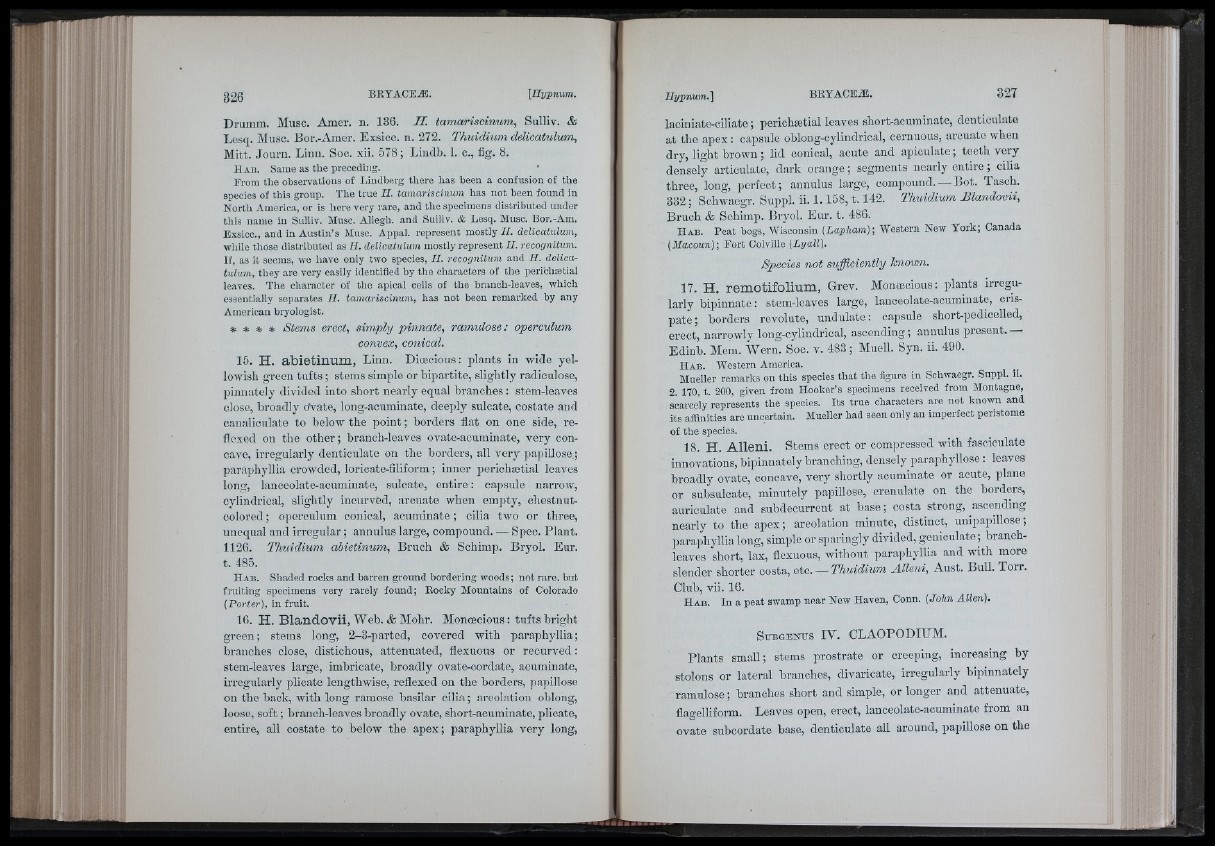
' - ;
Drumm. Musc. Amer. n. 136. H. tamariscinum, Sulliv. &
Lesq. Musc. Bor.-Amer. Exsicc. n. 272. Thuidium delicatulum,
Mitt. Journ. Liim. Soc. xii. 578 ; Liiidb. 1. c., fig. 8.
H a b . Same as the preceding.
From tlie observations of Lindberg there has been a confusion of tlie
species of this group. The true H. tamariscinum has not been found in
North America, or is here very rare, and the specimens distributed under
tills name In Sulliv. Muse. Allegh. and Sulliv. & Lesq. Muse. Bor.-Am.
Exsicc., and in Austin’s Muse. Appal, represent mostly II. delicatulum,
while tliose distributed as II. delicatulum mostly represent II. recognitum.
If, as it seems, we have only two species, II. recognitum and II. delicct-
tulum, they are very easily identified by the characters of the perichætial
leaves. Tile character of the apical cells of tlie branch-leaves, which
essentially separates II. tamariscinum, has not been remarked by any
American bryologist.
* * * * Stems erect, simply pinnate, ramidose : operculum
convex, conical.
15. H. ab ie tin um , Linn. Dioeoious: plants in wide yellowish
green tnfts ; stems simple or bipartite, slightly radiculose,
pinnately divided into short nearly equal branches : stem-leaves
close, broadly oVate, long-aonininate, deeply sulcate, costate and
canaliculate to below the point ; borders flat on one side, reflexed
on the other; branch-leaves ovate-acuminate, very concave,
irregularly denticulate on the borders, all very papiUose.;
paraphyllia crowded, loricate-filiform ; inner perichætial leaves
long, lanceolate-acuminate, sulcate, entire : capsule narrow,
cylindrical, slightly incurved, arcnate when empty, chestnut-
colored ; operculum conical, acuminate ; cilia two or three,
unequal and in-egular ; annulus large, compound. — Spec. Plant.
1126. Thuidium abietinum, Bruch & Schimp. Bryol. Eur.
t. 485.
IIa b . Shaded rocks and barren ground bordering woods ; not rare, but
fruiting specimens very rarely found; Eocky Mountains of Colorado
(Porter), in fruit.
16. H. Blandovii, Web. Æ Mohr. Monoecious : tnfts bright
green; steins long, 2-3-parted, covered with paraphyllia;
branches close, distichous, attenuated, flexuous or recurved :
stem-leaves large, imbricate, broadly ovate-oordate, acuminate,
irregularly plicate lengthwise, reflexed on the borders, papillose
on the hack, with long ramose hasilar cilia ; areolation oblong,
loose, soft ; branch-leaves broadly ovate, short-acuminate, plicate,
entire, all costate to below the apex; paraphyllia very long.
laciniate-ciliate ; perichætial leaves short-acuminate, denticulate
at the apex : capsule oblong-cylindrical, cernuous, arcuate when
dry, light brown ; lid conical, acute and apiculate ; teeth very
densely articulate, dark orange ; segments nearly entire ; cilia
three, long, perfect; annulus largo, compound. — Bot. Tasoh.
332 ; Schwaegr. Suppl. ii. 1.158,1.142. Thuidium Blandovii,
Bruch & Schimp. Bryol. Eur. t. 486.
H a b . Peat bogs, AVisconsin (Lapham); Western New York; Canada
(Macoun); Eort Colville (Lyall).
Species not sufficiently known.
17. H. r em o tifo lium , Grev. Monoecious: plants irregularly
bipinnate: stem-leaves large, lanceolate-acuminate, críspate;
borders revolute, undulate: capsule short-pedicelled,
erect, narrowly long-cylindrical, ascending ; annulus present. —
Edinb. Mem. Wern. Soc. v. 483 ; Muell. Syn. ii. 490.
H a b . AVestern America.
Mueller remarks on this species that the figure in Schwaegr. Suppl. li.
2. 170, t. 200, given from Hooker’s specimens received from Montagne,
Scarcely represents the species. Its true characters are not known and
its affinities are uncertain. Mueller had seen only an imperfect peristome
of tiie species.
18. H. Allen i. Stems erect or compressed with fasciculate
innovations, bipinnately branching, densely paraphyllose : leaves
broadly ovate, concave, very shortly acuminate or acute, plane
or subsulcate, minutely papillose, crenulate on the borders,
auricnlate and subdecurrent at base; costa strong, ascending
nearly to the apex; areolation minute, distinct, unipapillose;
paraphyllia long, simple or sparingly divided, geniculate ; branch-
leaves short, lax, flexuous, without paraphyllia and with more
slender shorter costa, etc. — Thuidium Alleni, Aust. Bull. Torr.
Club, vii. 16.
H a b . In a peat swamp near New Haven, Conn. (John Allen).
S a j b g b s t u s IV. CLAOPODIUM.
Plants small; stems prostrate or creeping, increasing by
stolons or lateral branches, divaricate, irregularly bipinnately
ramulose ; branches short and simple, or longer and attenuate,
flagelliform. Leaves open, erect, lanceolate-acuminate from an
ovate suboordate base, denticulate all around, papillose on the